Tsoulfanidis N. Measurement and detection of radiation
Подождите немного. Документ загружается.

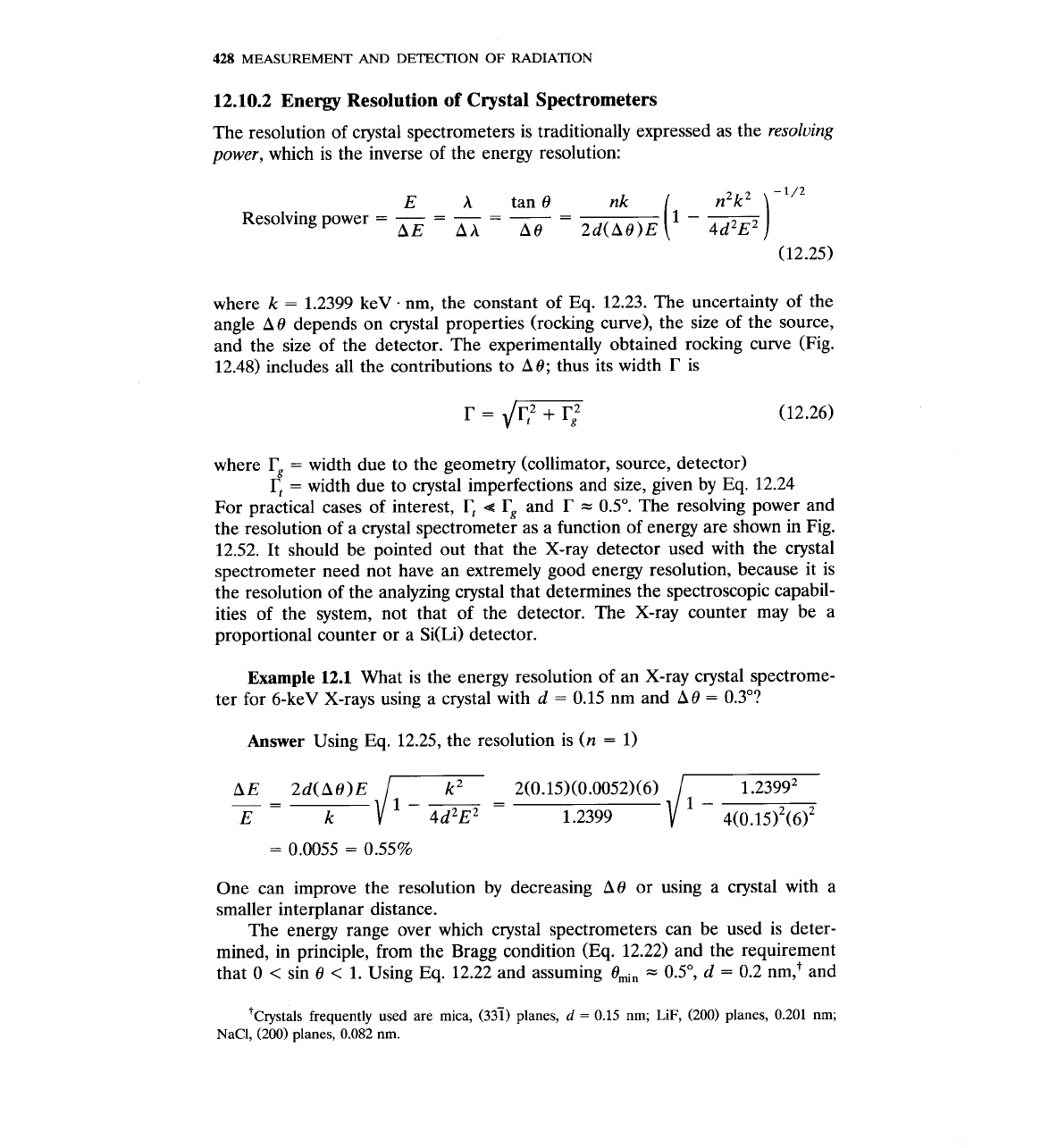
428
MEASUREMENT
AND DETECTION OF RADIATION
12.10.2
Energy Resolution of Crystal Spectrometers
The resolution of crystal spectrometers is traditionally expressed as the resolving
power, which is the inverse of the energy resolution:
n2k2
-1/2
E
A
tan 0 nk
Resolving power
=
-
=
-
=
-
=
AE Ah A0 2d(AO)E
where
k
=
1.2399 keV
.
nm, the constant of
Eq.
12.23. The uncertainty of the
angle A0 depends on crystal properties (rocking curve), the size of the source,
and the size of the detector. The experimentally obtained rocking curve (Fig.
12.48) includes all the contributions to AO; thus its width
r
is
where
Tg
=
width due to the geometry (collimator, source, detector)
r,
=
width due to crystal imperfections and size, given by
Eq.
12.24
For practical cases of interest,
T,
4
Tg
and
r
=
0.5". The resolving power and
the resolution of a crystal spectrometer as a function of energy are shown in Fig.
12.52. It should be pointed out that the X-ray detector used with the crystal
spectrometer need not have an extremely good energy resolution, because it is
the resolution of the analyzing crystal that determines the spectroscopic capabil-
ities of the system, not that of the detector. The X-ray counter may be a
proportional counter or a
Si(Li) detector.
Example
12.1
What is the energy resolution of an X-ray crystal spectrome-
ter for 6-keV X-rays using a crystal with d
=
0.15 nm and A0
=
0.3"?
Answer
Using
Eq.
12.25, the resolution is (n
=
1)
One can improve the resolution by decreasing A6 or using a crystal with a
smaller interplanar distance.
The energy range over which crystal spectrometers can be used is deter-
mined, in principle, from the Bragg condition
(Eq.
12.22) and the requirement
that 0
<
sin 0
<
1.
Using
Eq.
12.22 and assuming
Omin
=
OSO, d
=
0.2 nm,? and
t~rystals frequently used are mica,
(331)
planes,
d
=
0.15 nm;
LiF,
(200) planes, 0.201 nm;
NaCI, (200) planes, 0.082 nm.
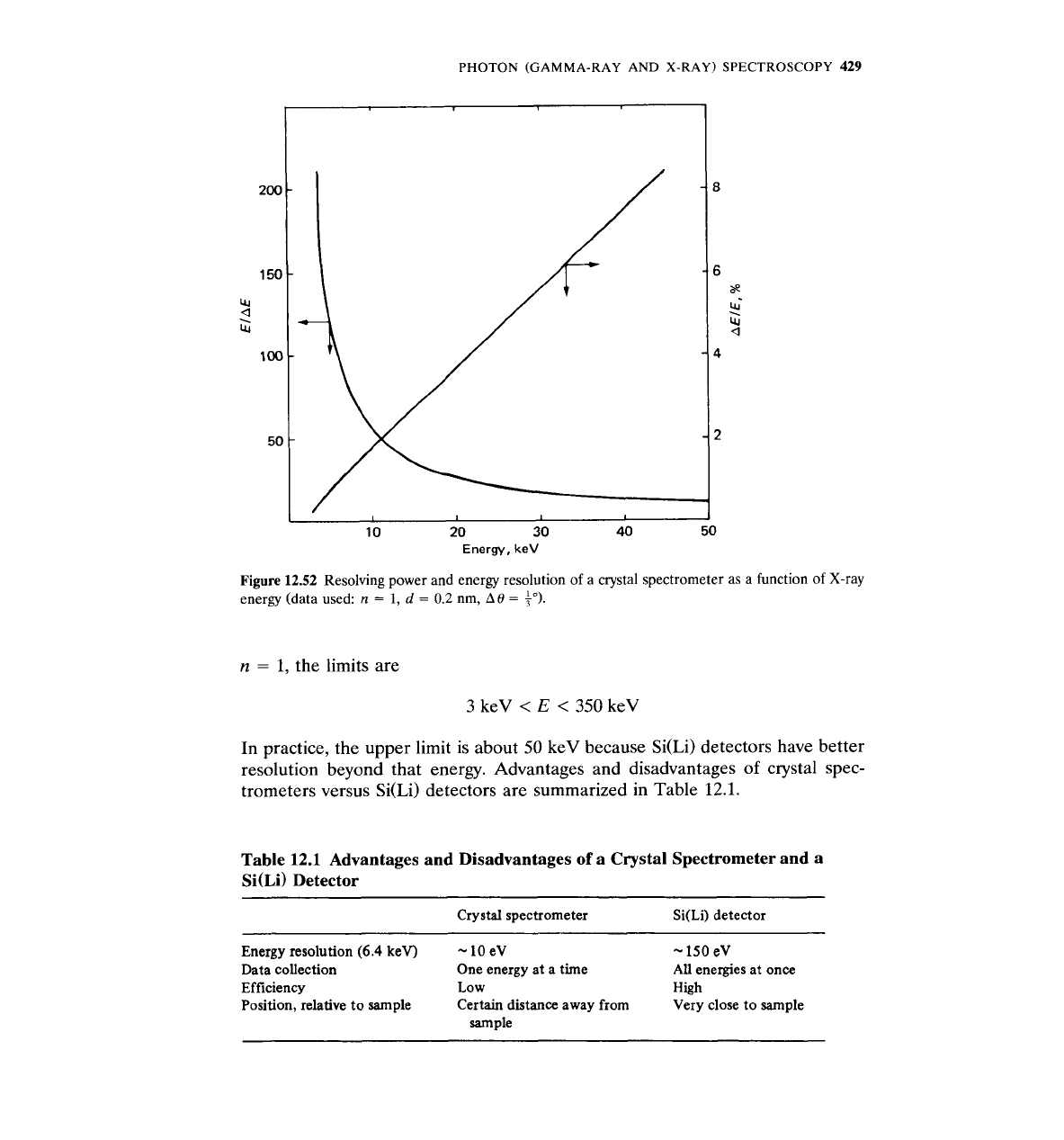
PHOTON
(GAMMA-RAY
AND
X-RAY)
SPECTROSCOPY
429
/
I
I
1
I
10
20
30
40
Energy, keV
Figure
12.52
Resolving power and energy resolution
of
a crystal spectrometer as a function
of
X-ray
energy (data
used:
n
=
1,
d
=
0.2
nm,
A0
=
to).
n
=
1,
the limits are
In practice, the upper limit is about
50
keV because Si(Li) detectors have better
resolution beyond that energy. Advantages and disadvantages of crystal spec-
trometers versus Si(Li) detectors are summarized in Table
12.1.
Table
12.1
Advantages and Disadvantages of a Crystal Spectrometer and a
Si(Li) Detector
Crystal spectrometer Si(Li) detector
-
-
Energy resolution
(6.4
keV)
-
10
eV
-
150
eV
Data collection One energy at a time
All energies at once
Efficiency Low
High
Position, relative to sample Certain distance away from
Very close to sample
sample
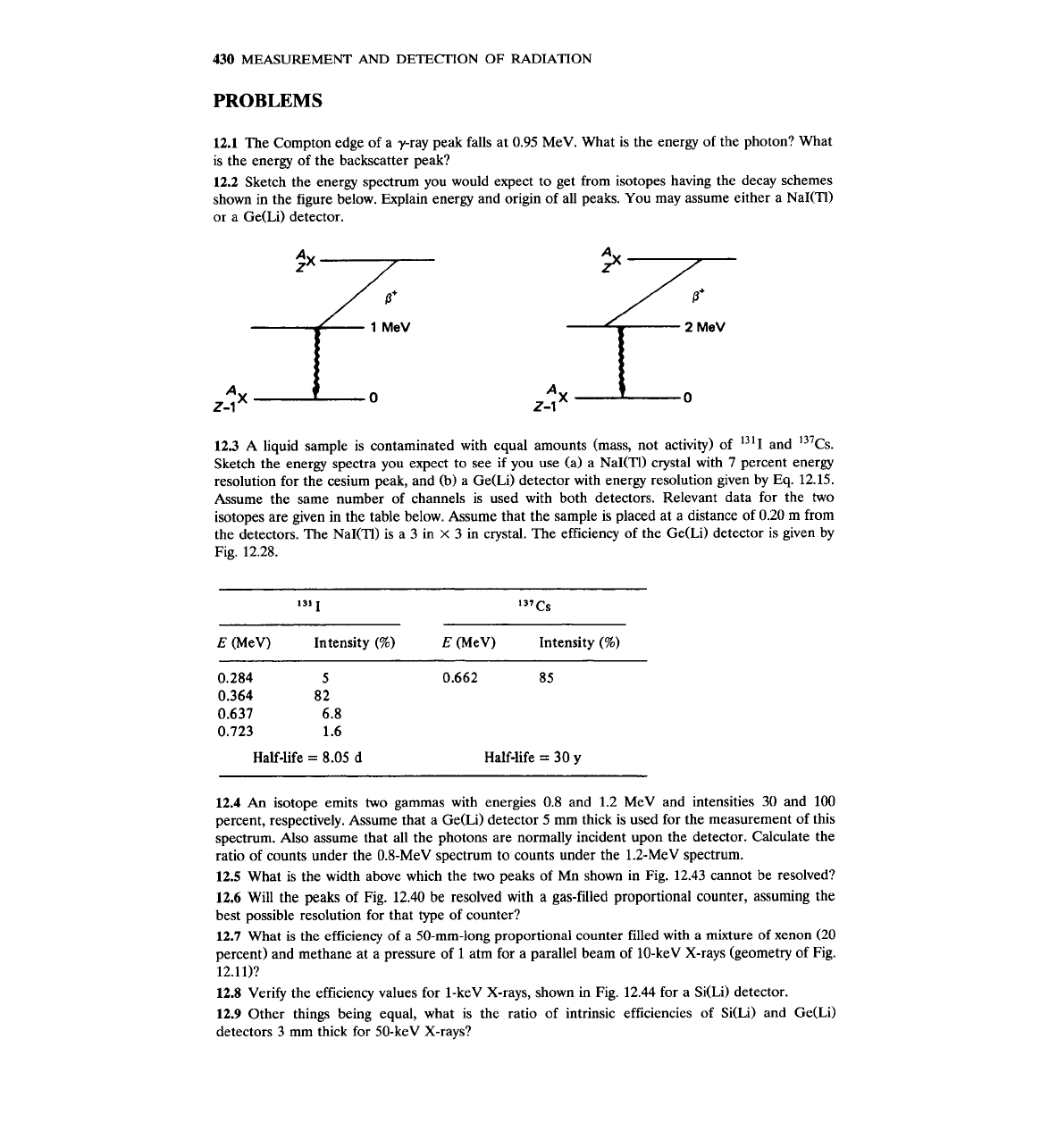
430
MEASUREMENT AND DETECTION OF RADIATION
PROBLEMS
12.1
The Compton edge of a Fray peak falls at 0.95 MeV. What is the energy of the photon? What
is the energy of the backscatter peak?
12.2
Sketch the energy spectrum you would expect to get from isotopes having the decay schemes
shown in the figure below. Explain energy and origin of all peaks. You may assume either a NaI(TI)
or a Ge(Li) detector.
12.3
A liquid sample is contaminated with equal amounts (mass, not activity) of
13'1
and '37Cs.
Sketch the energy spectra you expect to see if you use (a) a NaI(T1) crystal with
7
percent energy
resolution for the cesium peak, and (b) a Ge(Li) detector with energy resolution given by Eq. 12.15.
Assume the same number of channels is used with both detectors. Relevant data for the two
isotopes are given in the table below. Assume that the sample is placed at a distance of 0.20 m from
the detectors. The NaI(TI) is a 3 in
X
3 in crystal. The efficiency of the Ge(Li) detector is given by
Fig. 12.28.
I31
1
13'Cs
E
(MeV) Intensity
(%)
E
(MeV) Intensity
(%)
Half-life
=
8.05
d Half-life
=
30 y
12.4
An
isotope emits two gammas with energies 0.8 and 1.2 MeV and intensities 30 and 100
percent, respectively. Assume that a Ge(Li) detector 5 mm thick is used for the measurement of this
spectrum. Also assume that all the photons are normally incident upon the detector. Calculate the
ratio of counts under the 0.8-MeV spectrum to counts under the 1.2-MeV spectrum.
12.5
What is the width above which the two peaks of Mn shown in Fig. 12.43 cannot be resolved?
12.6
Will the peaks of Fig. 12.40 be resolved with a gas-filled proportional counter, assuming the
best possible resolution for that type of counter?
12.7
What is the efficiency of a 50-mm-long proportional counter filled with a mixture of xenon (20
percent) and methane at a pressure of
1
atm for a parallel beam of 10-keV X-rays (geometry of Fig.
12.11)?
12.8
Verify the efficiency values for 1-keV X-rays, shown in Fig. 12.44 for a Si(Li) detector.
12.9
Other things being equal, what is the ratio of intrinsic efficiencies of Si(Li) and Ge(Li)
detectors 3 mm thick for 50-keV X-rays?
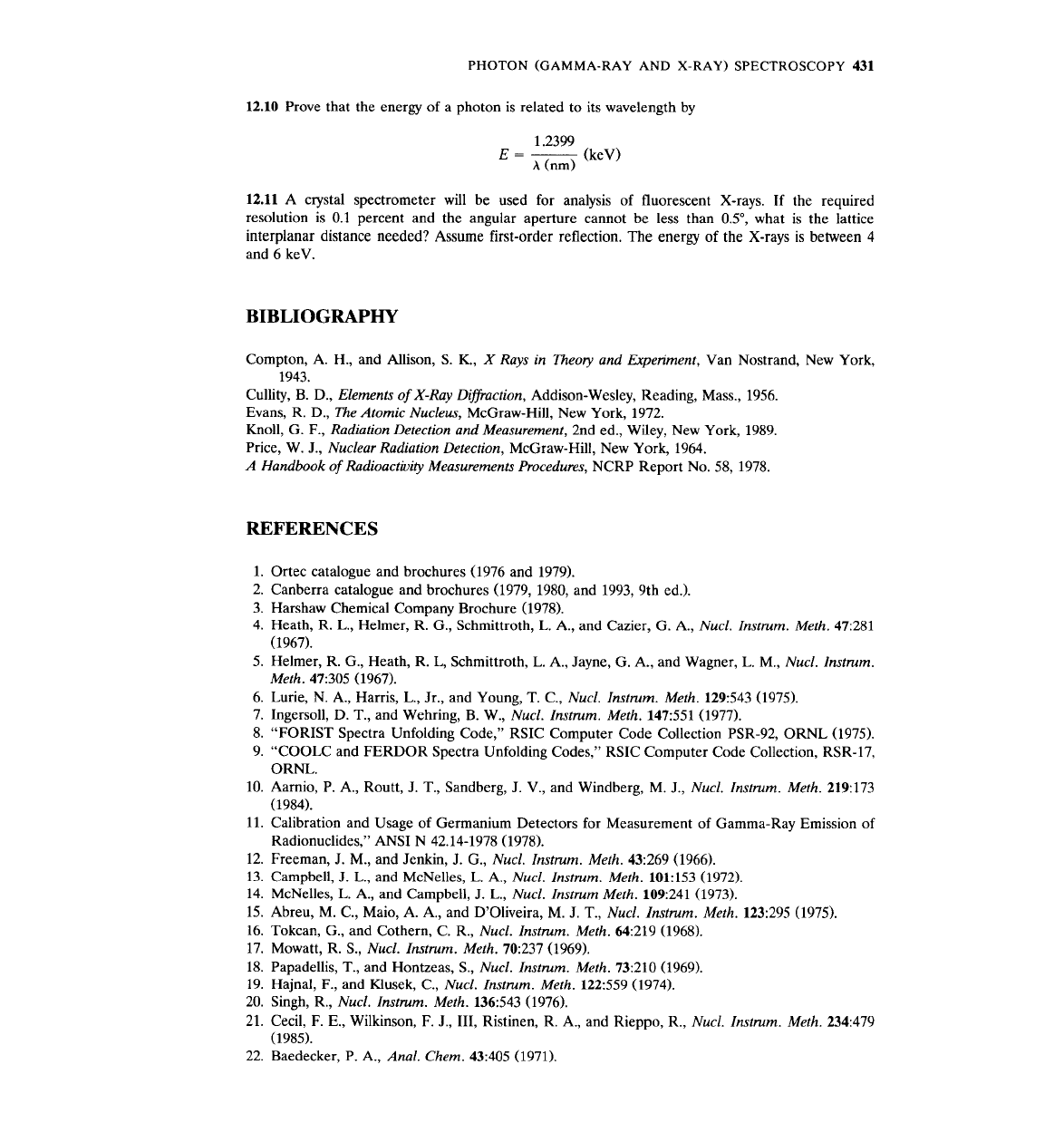
PHOTON (GAMMA-RAY AND X-RAY) SPECTROSCOPY 431
12.10
Prove that the energy of a photon is related to its wavelength by
12.11
A crystal spectrometer will be used for analysis of fluorescent X-rays. If the required
resolution is
0.1
percent and the angular aperture cannot be less than
0.5",
what is the lattice
interplanar distance needed? Assume first-order reflection. The energy of the X-rays is between
4
and
6
keV.
BIBLIOGRAPHY
Compton, A. H., and Allison, S.
K.,
X
Rays in Theory and Experiment,
Van Nostrand, New York,
1943.
Cullity, B. D.,
Elements of X-Ray Diffraction,
Addison-Wesley, Reading, Mass.,
1956.
Evans,
R.
D.,
The Atomic Nucleus,
McGraw-Hill, New York,
1972.
Knoll,
G.
F.,
Radiation Detection and Measurement,
2nd ed., Wiley, New York,
1989.
Price, W.
J.,
Nuclear Radiation Detection,
McGraw-Hill, New York,
1964.
A Handbook of Radioactwity Measurements Procedures,
NCRP Report No.
58, 1978.
REFERENCES
Ortec catalogue and brochures
(1976
and
1979).
Canberra catalogue and brochures
(1979, 1980,
and
1993,
9th ed.).
Harshaw Chemical Company Brochure
(1978).
Heath,
R.
L., Helmer,
R.
G.,
Schmittroth, L.
A,,
and Cazier,
G.
A.,
Nucl. Instrum. Meth.
47:281
(1967).
Helmer, R.
G.,
Heath, R.
L,
Schmittroth,
L.
A,,
Jayne, G. A., and Wagner,
L.
M.,
Nucl. Instrum.
Meth.
47:305 (1967).
Lurie, N. A,, Harris,
L.,
Jr., and Young, T. C.,
Nucl. Instrurn. Meth.
129543 (1975).
Ingersoll,
D.
T.,
and Wehring, B. W.,
Nucl. Instrum. Meth.
147:551 (1977).
"FORIST Spectra Unfolding Code," RSIC Computer Code Collection PSR-92, ORNL
(1975).
"COOLC and FERDOR Spectra Unfolding Codes," RSIC Computer Code Collection,
RSR-17,
ORNL.
Aarnio,
P.
A,, Routt, J. T., Sandberg, J. V., and Windberg, M. J.,
Nucl. Instrum. Meth.
219:173
(1984).
Calibration and Usage of Germanium Detectors for Measurement of Gamma-Ray Emission of
Radionuclides," ANSI N
42.14-1978 (1978).
Freeman,
J.
M., and Jenkin, J.
G.,
Nucl. Instrum. Meth.
43:269 (1966).
Campbell,
J.
L.,
and McNelles, L.
A,,
Nucl. Instrum. Meth.
101:153 (1972).
McNelles,
L.
A.,
and Campbell, J. L.,
Nucl. Instrum Meth.
109:241 (1973).
Abreu, M. C., Maio,
A.
A., and D'Oliveira, M. J. T.,
Nucl. Instrum. Meth.
123:295 (1975).
Tokcan,
G.,
and Cothern, C. R.,
Nucl. Instrurn. Meth.
64:219 (1968).
Mowatt, R. S.,
Nucl. Instrum. Meth.
70:237 (1969).
Papadellis, T., and Hontzeas, S.,
Nucl. Instrum. Meth.
73:210 (1969).
Hajnal,
F.,
and Klusek, C.,
Nucl. Instrum. Meth.
122:559 (1974).
Singh, R.,
Nucl. Instrum. Meth.
136:543 (1976).
Cecil, F. E., Wilkinson,
F.
J.,
111, Ristinen,
R.
A,, and Rieppo, R.,
Nucl. Instrum. Meth.
234:479
(1985).
Baedecker,
P.
A.,
Anal. Chem.
43:405 (1971).
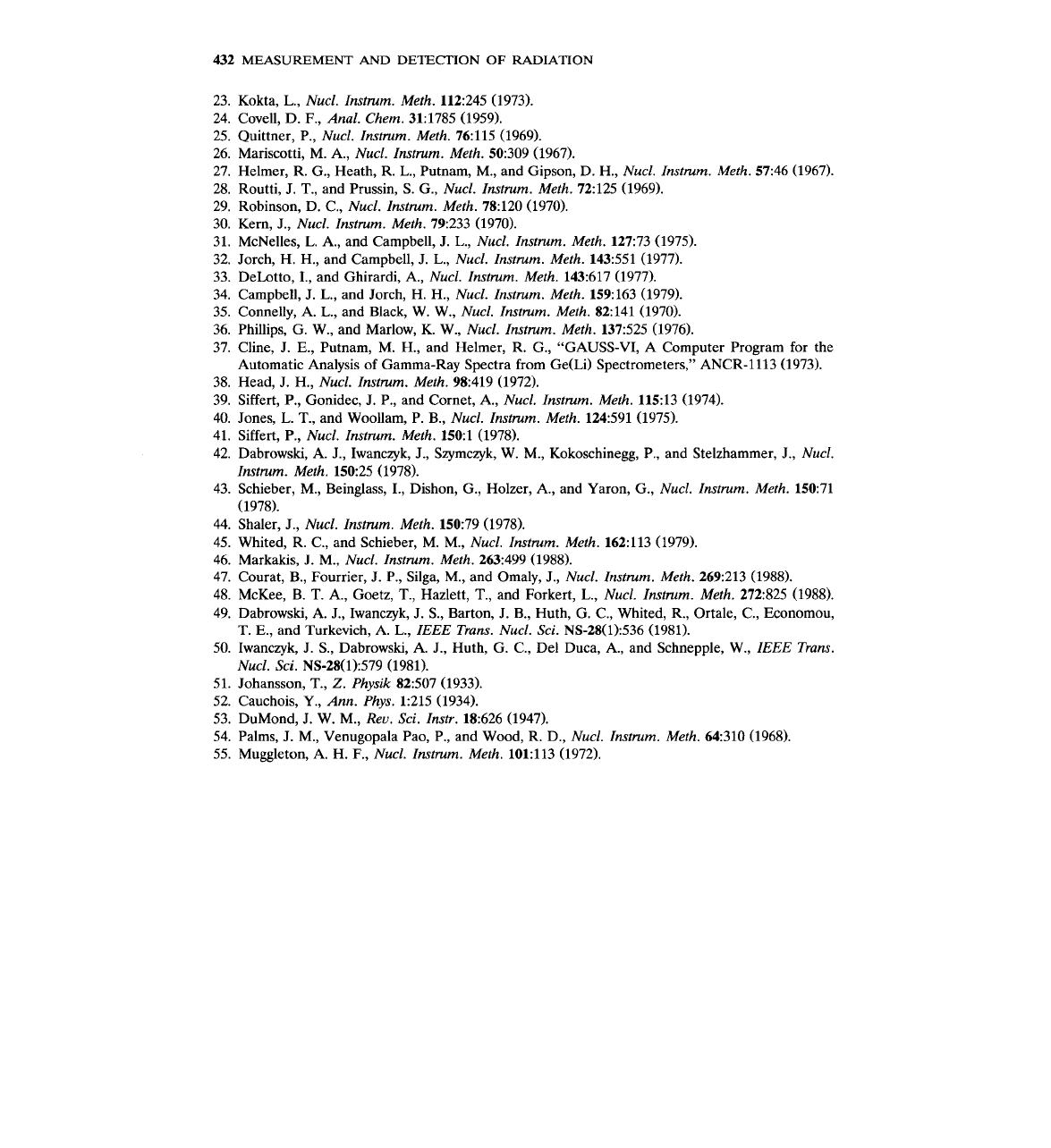
432 MEASUREMENT AND DETECTION OF RADIATION
23.
Kokta,
L.,
Nucl.
Instrum. Meth.
112:245 (1973).
24.
Covell,
D.
F.,
Anal. Chem.
31:1785 (1959).
25.
Quittner, P.,
Nucl.
Instrum. Meth.
76:115 (1969).
26.
Mariscotti, M. A,,
Nucl.
Instrum. Meth.
50:309 (1967).
27.
Helmer, R. G., Heath, R. L., Putnam, M., and Gipson, D. H.,
Nucl.
Instrum. Meth.
57:46 (1967).
28.
Routti,
J.
T.,
and Prussin, S. G.,
Nucl.
Inshum. Meth.
72:125 (1969).
29.
Robinson, D. C.,
Nucl.
Instrum. Meth.
78:120 (1970).
30.
Kern, J.,
Nucl.
Instrum. Meth.
79:233 (1970).
31.
McNelles,
L.
A,, and Campbell, J. L.,
Nucl.
Instrum. Meth.
127:73 (1975).
32.
Jorch,
H.
H.,
and Campbell,
J.
L.,
Nucl.
Instrum. Meth.
143:551 (1977).
33.
DeLotto, I., and Ghirardi, A.,
Nucl.
Instrum. Meth.
143517 (1977).
34.
Campbell, J.
L.,
and Jorch, H. H.,
Nucl.
Instrum. Meth.
159:163 (1979).
35.
Connelly,
A.
L., and Black, W. W.,
Nucl.
Instrum. Meth.
82:141 (1970).
36.
Phillips, G.
W.,
and Marlow, K. W.,
Nucl.
Instrum. Meth.
137:525 (1976).
37.
Cline, J.
E.,
Putnam,
M.
H., and Helmer, R. G., "GAUSS-VI, A Computer Program for the
Automatic Analysis of Gamma-Ray Spectra from Ge(Li) Spectrometers,"
ANCR-1113 (1973).
38.
Head, J.
H.,
Nucl.
Instrum. Meth.
98:419 (1972).
39.
Siffert,
P.,
Gonidec,
J.
P., and Cornet, A.,
Nucl.
Instrum. Meth.
115:13 (1974).
40.
Jones,
L.
T.,
and Woollam, P. B.,
Nucl.
Instrum. Meth.
124:591 (1975).
41.
Siffert,
P.,
Nucl.
Instrum. Meth.
150:l (1978).
42.
Dabrowski,
A.
J., Iwanczyk,
J.,
Szymczyk, W. M., Kokoschinegg,
P.,
and Stelzhammer, J.,
Nucl.
Instrum. Meth.
150:25 (1978).
43.
Schieber, M., Beinglass,
I.,
Dishon,
G.,
Holzer, A,, and Yaron, G.,
Nucl.
Instrum. Meth.
150:71
(1978).
44.
Shaler,
J.,
Nucl.
Instrum. Meth.
150:79 (1978).
45.
Whited, R. C., and Schieber, M.
M.,
Nucl.
Instrum. Meth.
162:113 (1979).
46.
Markakis,
J.
M.,
Nucl.
Instrum. Meth.
263:499 (1988).
47.
Courat, B., Fourrier, J.
P.,
Silga, M., and Omaly, J.,
Nucl.
Instrum. Meth.
269:213 (1988).
48.
McKee,
B.
T.
A,, Goetz,
T.,
Hazlett,
T.,
and Forkert,
L.,
Nucl.
Instrum. Meth.
2722325 (1988).
49.
Dabrowski, A. J., Iwanczyk,
J.
S., Barton, J. B., Huth, G. C., Whited, R., Ortale, C., Economou,
T.
E.,
and Turkevich, A.
L.,
IEEE Trans.
Nucl. Sci.
NS-28(1):536 (1981).
50.
Iwanczyk, J. S., Dabrowski, A. J., Huth, G. C., Del Duca, A., and Schnepple, W.,
IEEE Trans.
Nucl. Sci.
NS-28(1):579 (1981).
51.
Johansson,
T.,
Z.
Physik
82:507 (1933).
52.
Cauchois,
Y.,
Ann. Phys.
1:215 (1934).
53.
DuMond,
J.
W. M.,
Reu.
Sci.
Instr.
18:626 (1947).
54.
Palms, J. M., Venugopala Pao, P., and Wood, R. D.,
Nucl.
Instrum. Meth.
64310 (1968).
55.
Muggleton, A. H. F.,
Nucl.
Instrum. Meth.
101:113 (1972).
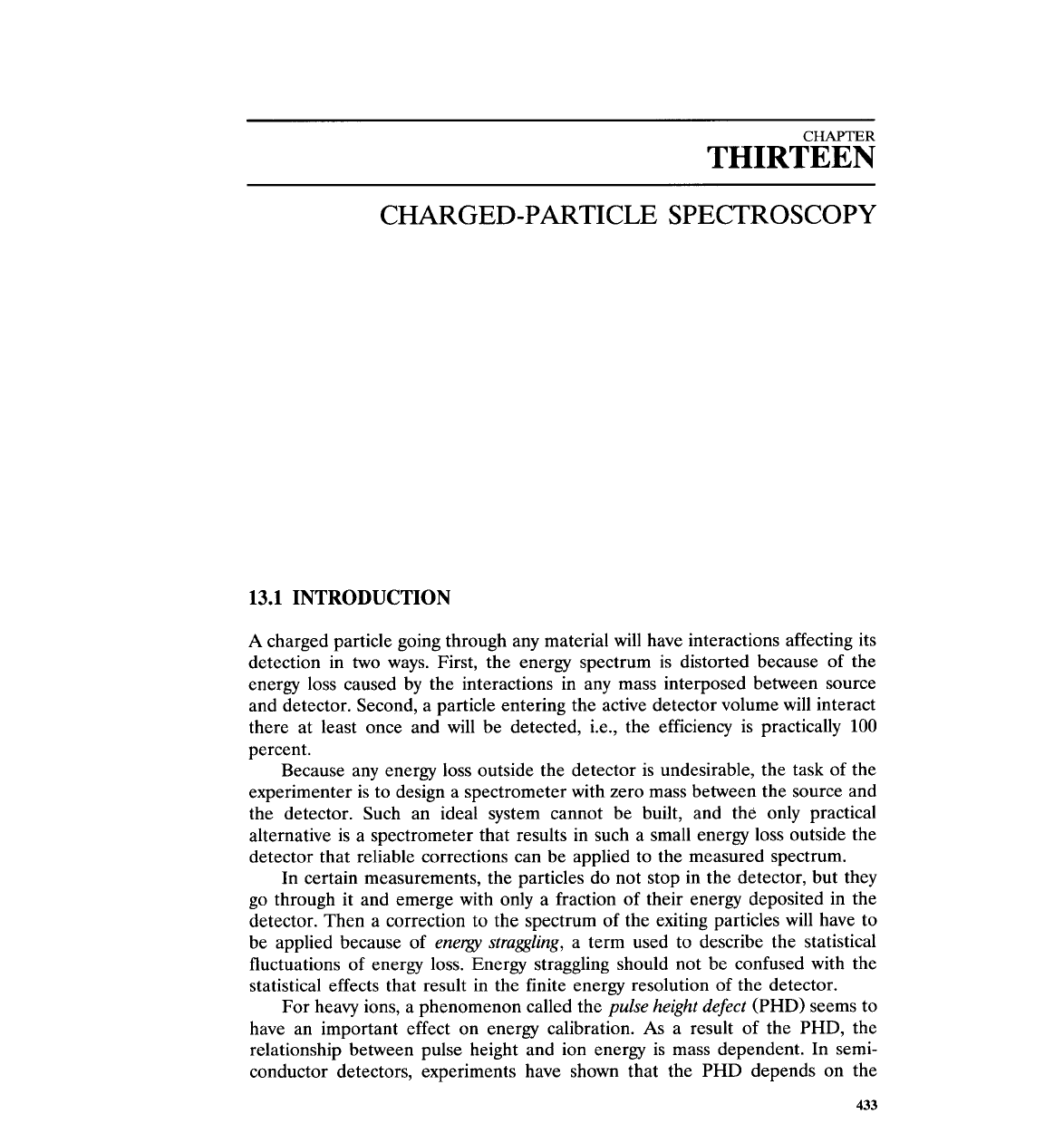
CHAPTER
THIRTEEN
CHARGED-PARTICLE SPECTROSCOPY
13.1
INTRODUCTION
A charged particle going through any material will have interactions affecting its
detection in two ways. First, the energy spectrum is distorted because of the
energy loss caused by the interactions in any mass interposed between source
and detector. Second, a particle entering the active detector volume will interact
there at least once and will be detected, i.e., the efficiency is practically
100
percent.
Because any energy loss outside the detector is undesirable, the task of the
experimenter is to design a spectrometer with zero mass between the source and
the detector. Such an ideal system cannot be built, and the only practical
alternative is a spectrometer that results in such a small energy loss outside the
detector that reliable corrections can be applied to the measured spectrum.
In certain measurements, the particles do not stop in the detector, but they
go through it and emerge with only a fraction of their energy deposited in the
detector. Then a correction to the spectrum of the exiting particles will have to
be applied because of energy straggling, a term used to describe the statistical
fluctuations of energy loss. Energy straggling should not be confused with the
statistical effects that result in the finite energy resolution of the detector.
For heavy ions, a phenomenon called the pulse height defect (PHD) seems to
have an important effect on energy calibration. As a result of the PHD, the
relationship between pulse height and ion energy is mass dependent. In semi-
conductor detectors, experiments have shown that the PHD depends on the
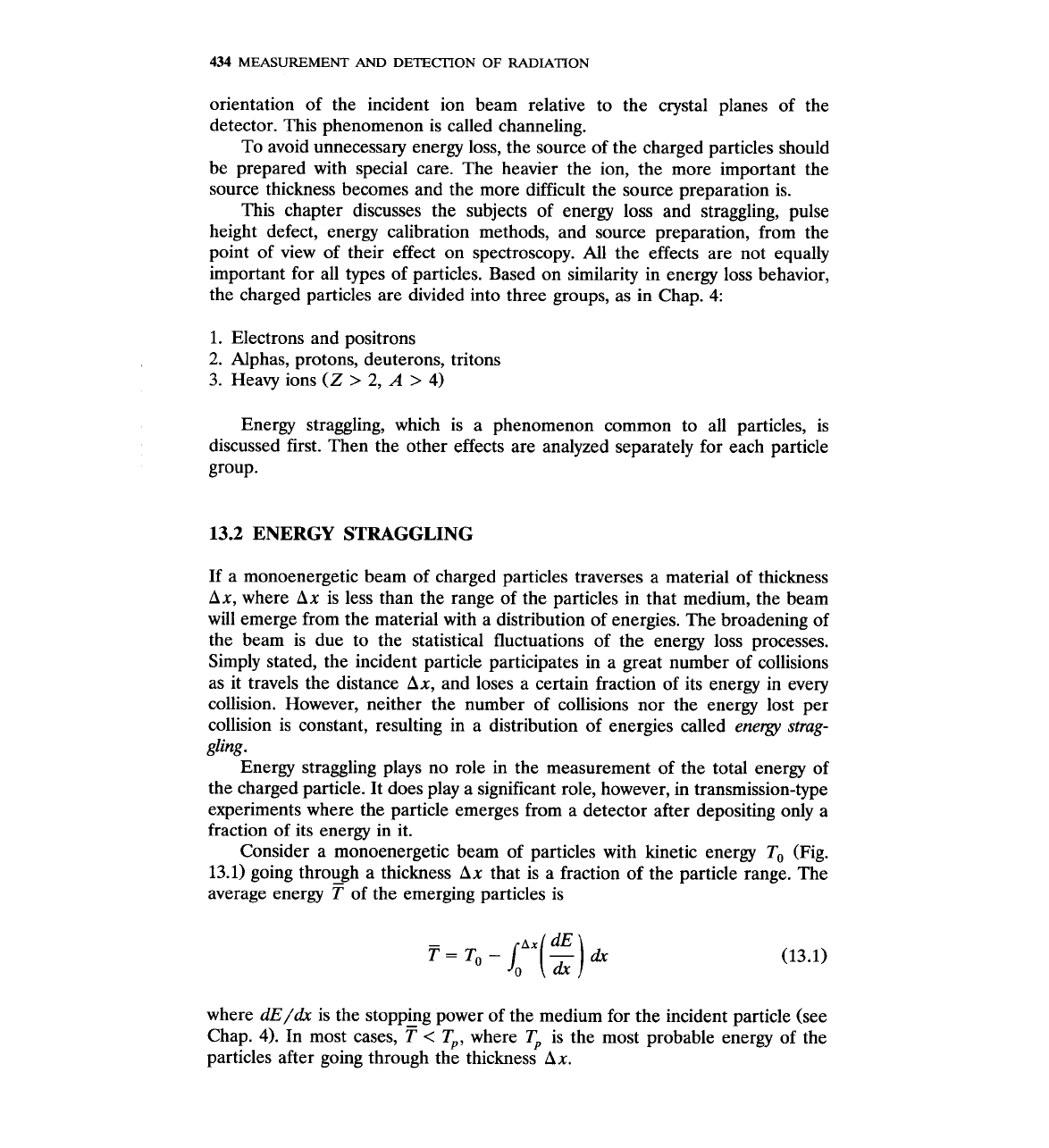
434
MEASUREMENT
AND
DETECTION
OF
RADIATION
orientation of the incident ion beam relative to the crystal planes of the
detector. This phenomenon is called channeling.
To avoid unnecessary energy loss, the source of the charged particles should
be prepared with special care. The heavier the ion, the more important the
source thickness becomes and the more difficult the source preparation is.
This chapter discusses the subjects of energy loss and straggling, pulse
height defect, energy calibration methods, and source preparation, from the
point of view of their effect on spectroscopy. All the effects are not equally
important for all types of particles. Based on similarity in energy loss behavior,
the charged particles are divided into three groups, as in Chap. 4:
1.
Electrons and positrons
2. Alphas, protons, deuterons, tritons
3. Heavy ions
(Z
>
2,
A
>
4)
Energy straggling, which is a phenomenon common to all particles, is
discussed first. Then the other effects are analyzed separately for each particle
group.
13.2
ENERGY STRAGGLING
If a monoenergetic beam of charged particles traverses a material of thickness
Ax, where Ax is less than the range of the particles in that medium, the beam
will emerge from the material with a distribution of energies. The broadening of
the beam is due to the statistical fluctuations of the energy loss processes.
Simply stated, the incident particle participates in a great number of collisions
as it travels the distance Ax, and loses a certain fraction of its energy in every
collision. However, neither the number of collisions nor the energy lost per
collision is constant, resulting in a distribution of energies called
energy
strag-
gling.
Energy straggling plays no role in the measurement of the total energy of
the charged particle. It does play a significant role, however, in transmission-type
experiments where the particle emerges from a detector after depositing only a
fraction of its energy in it.
Consider a monoenergetic beam of particles with kinetic energy
To
(Fig.
13.1) going through a thickness Ax that is a fraction of the particle range. The
average energy
T
of the emerging particles is
where
dE/dx
is the stopping power of the medium for the incident particle (see
Chap. 4). In most cases,
T
<
Tp,
where
Tp
is the most probable energy of the
particles after going through the thickness Ax.
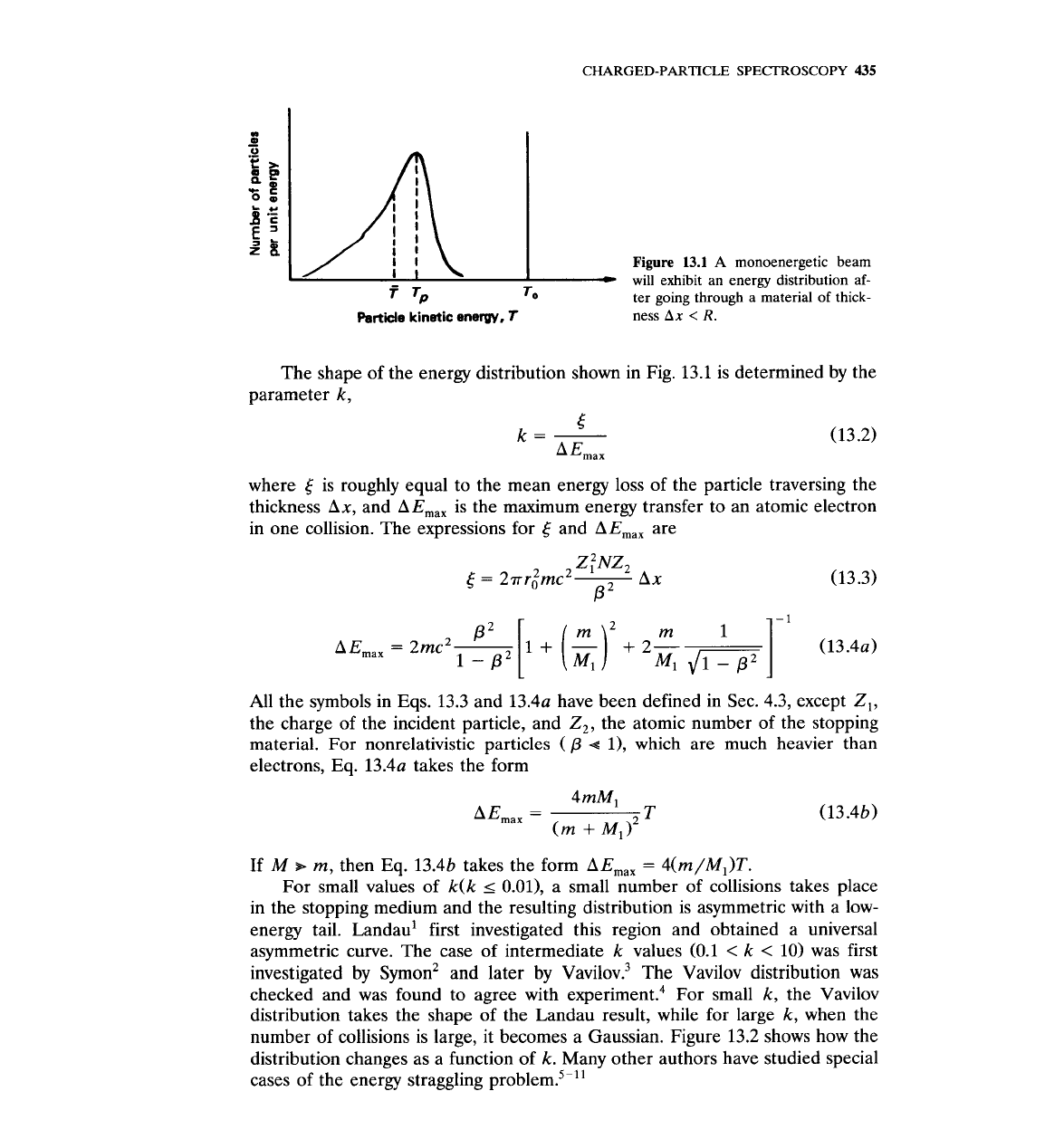
CHARGED-PARTICLE
SPECTROSCOPY
435
L
will
Figure
exhibit
13.1
an
A
energy monoenergetic distribution beam af-
7
Tp
To
ter going through a material of thick-
Partide kinetic energy,
T
ness
Ax
<
R.
The shape of the energy distribution shown in Fig. 13.1 is determined by the
parameter k,
where
6
is roughly equal to the mean energy loss of the particle traversing the
thickness
Ax,
and
AE,,,
is the maximum energy transfer to an atomic electron
in one collision. The expressions for
5
and
AEmaX
are
All the symbols in Eqs. 13.3 and 13.4~ have been defined in Sec. 4.3, except Z,,
the charge of the incident particle, and Z,, the atomic number of the stopping
material. For nonrelativistic particles
(
P
-s
I),
which are much heavier than
electrons, Eq. 13.4~ takes the form
If M
P
m, then Eq. 13.4b takes the form
AEmaX
=
4(m/Ml)T.
For small values of k(k
I
0.01), a small number of collisions takes place
in the stopping medium and the resulting distribution is asymmetric with
a
low-
energy tail. ~andau' first investigated this region and obtained a universal
asymmetric curve. The case of intermediate k values (0.1
<
k
<
10) was first
investigated by Symon2 and later by ~avilov.~ The Vavilov distribution was
checked and was found to agree with e~~eriment.~ For small k, the Vavilov
distribution takes the shape of the Landau result, while for large k, when the
number of collisions is large, it becomes a Gaussian. Figure 13.2 shows how the
distribution changes as a function of k. Many other authors have studied special
cases of the energy straggling

436
MEASUREMENT
AND
DETECTION
OF
RADIATION
Figure
13.2
The Vavilov distribution shown for various values of the parameter
k.
The quantity
q5
is
a measure of the probability that a particle will lose energy between
T
and
T
+
dT
in traversing
thickness
Ax.
The parameter
A
=
(T
-
T)/[
-
0.423
-
P2
-
In
k
(from Ref.
11).
The variance of the energy straggling distribution was first calculatedt by
~ohr'~ using a classical model. Bohr's result is
where
AT
=
energy loss in a specific case
m=
average energy loss given by (Eq. 13.1)
To
-
T
The width
r
of the distribution is equal to (2mXu,).
Livingston and ~ethe'~ obtained a different expression by incorporating
quantum-mechanical concepts into the calculation. Their result is
where
Z;
=
effective atomic number of the stopping material
Ii,
Zi
=
ionization potential and number of electrons, respectively, in the
ith atomic shell of the stopping material
AEmax
is given by
Eq.
13.4~.
A
third expression for u: was obtained by
Titeica.14 It is worth noting that Bohr's result (Eq. 13.5) is independent of the
particle energy, while the Beth-Livingston
(Eq.
13.6) and the Titeica result have
a small energy dependence.
The expressions for
u; mentioned above were all obtained by taking into
account electronic collisions only. Nuclear collisions (see Chap. 4) are rare, but
they cause large energy losses.
As
a result, they do not contribute significantly to
the average energy loss but they do influence the energy distribution by giving it
a low-energy tail. (The energy
loss
distribution will have a high-energy tail.)
h he
calculation is presented by Evans and by Segrk (see bibliography of this chapter).
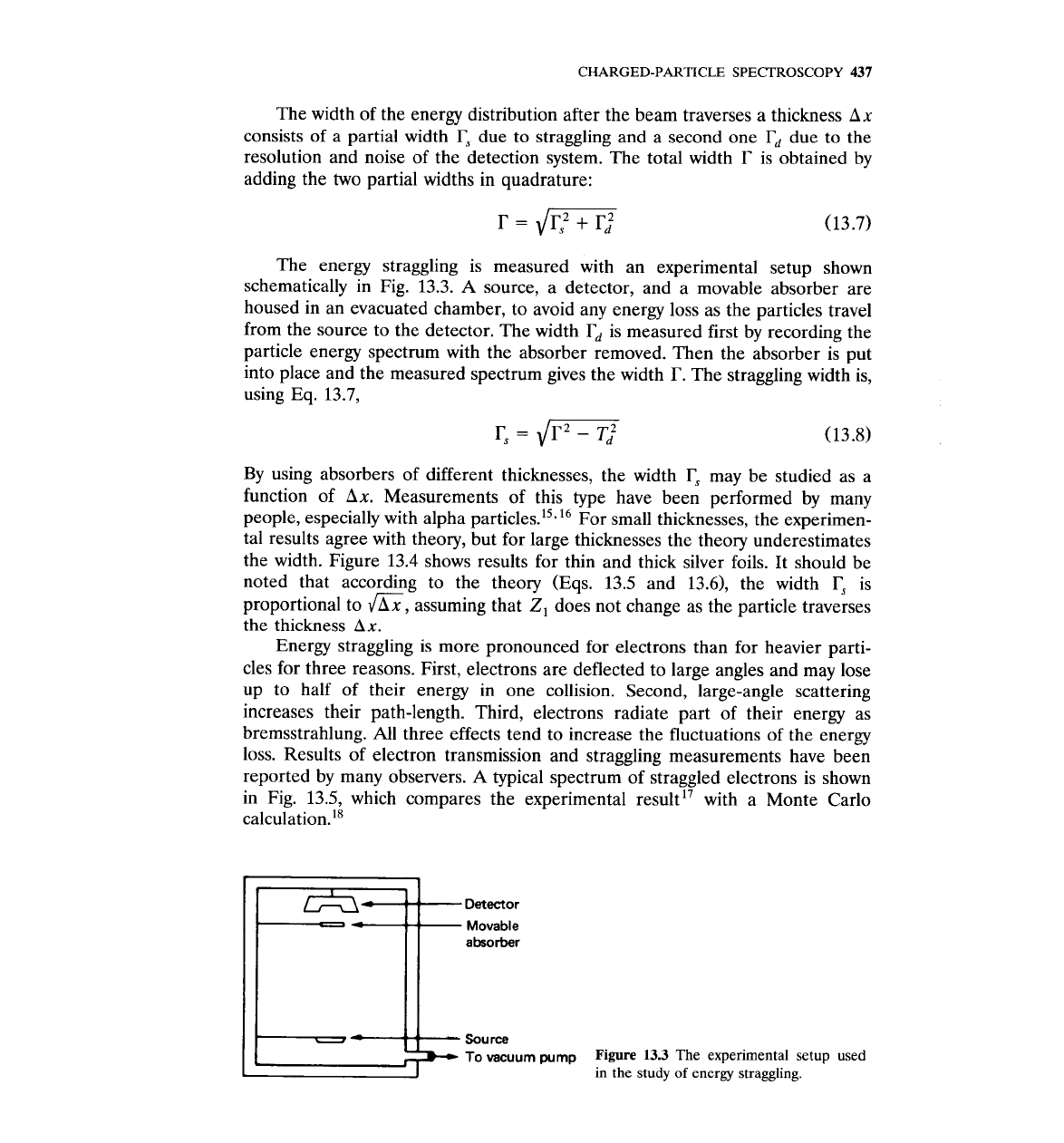
CHARGED-PARTICLE SPECTROSCOPY
437
The width of the energy distribution after the beam traverses a thickness
Ax
consists of a partial width
T,
due to straggling and a second one
rd
due to the
resolution and noise of the detection system. The total width
r
is obtained by
adding the two partial widths in quadrature:
The energy straggling is measured with an experimental setup shown
schematically in Fig.
13.3.
A
source, a detector, and a movable absorber are
housed in an evacuated chamber, to avoid any energy loss as the particles travel
from the source to the detector. The width
rd
is measured first by recording the
particle energy spectrum with the absorber removed. Then the absorber is put
into place and the measured spectrum gives the width
T.
The straggling width is,
using Eq. 13.7,
By using absorbers of different thicknesses, the width
rs
may be studied as a
function of
Ax.
Measurements of this type have been performed by many
people, especially with alpha particles.15.16 For small thicknesses, the experimen-
tal results agree with theory, but for large thicknesses the theory underestimates
the width. Figure 13.4 shows results for thin and thick silver foils. It should be
noted that according to the theory (Eqs.
13.5
and 13.61, the width
Ts
is
proportional to
a,
assuming that Zl does not change as the particle traverses
the thickness
Ax.
Energy straggling is more pronounced for electrons than for heavier parti-
cles for three reasons. First, electrons are deflected to large angles and may lose
up to half of their energy in one collision. Second, large-angle scattering
increases their path-length. Third, electrons radiate part of their energy as
bremsstrahlung. All three effects tend to increase the fluctuations of the energy
loss. Results of electron transmission and straggling measurements have been
reported by many observers.
A
typical spectrum of straggled electrons is shown
in Fig.
13.5,
which compares the experimental result1' with a Monte Carlo
~alculation.'~
-
Detector
--1e
--
Movable
absorber
Source
To
vacuum pump
Figure
13.3
The experimental setup used
in the study
of
energy straggling.
